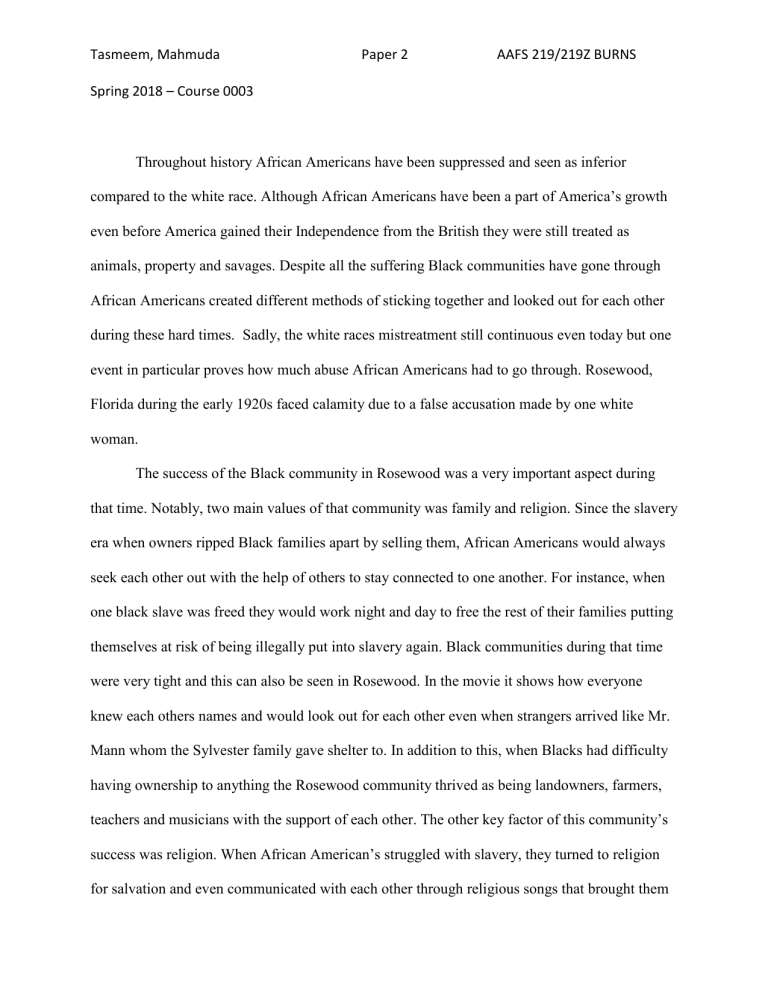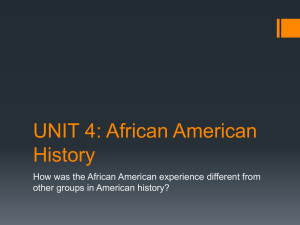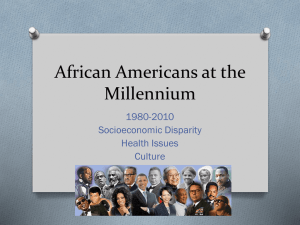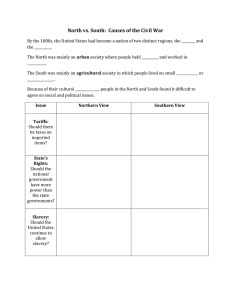Rosewood Essay
advertisement

Tasmeem, Mahmuda Paper 2 AAFS 219/219Z BURNS Spring 2018 – Course 0003 Throughout history African Americans have been suppressed and seen as inferior compared to the white race. Although African Americans have been a part of America’s growth even before America gained their Independence from the British they were still treated as animals, property and savages. Despite all the suffering Black communities have gone through African Americans created different methods of sticking together and looked out for each other during these hard times. Sadly, the white races mistreatment still continuous even today but one event in particular proves how much abuse African Americans had to go through. Rosewood, Florida during the early 1920s faced calamity due to a false accusation made by one white woman. The success of the Black community in Rosewood was a very important aspect during that time. Notably, two main values of that community was family and religion. Since the slavery era when owners ripped Black families apart by selling them, African Americans would always seek each other out with the help of others to stay connected to one another. For instance, when one black slave was freed they would work night and day to free the rest of their families putting themselves at risk of being illegally put into slavery again. Black communities during that time were very tight and this can also be seen in Rosewood. In the movie it shows how everyone knew each others names and would look out for each other even when strangers arrived like Mr. Mann whom the Sylvester family gave shelter to. In addition to this, when Blacks had difficulty having ownership to anything the Rosewood community thrived as being landowners, farmers, teachers and musicians with the support of each other. The other key factor of this community’s success was religion. When African American’s struggled with slavery, they turned to religion for salvation and even communicated with each other through religious songs that brought them Tasmeem, Mahmuda Paper 2 AAFS 219/219Z BURNS Spring 2018 – Course 0003 together. It is stated that, “music was a way for slaves to express their feelings whether it was sorrow, joy, inspiration or hope. Songs were passed down from generation to generation throughout slavery.” This can be seen with the people of Rosewood who never lost their religious values because they had at least two churches according to Trevor Goodloe. Moreover, when the death of Sam Carter was found out everyone gathered in the church and at the end of the meeting sang together because like in the past they knew that it may be their last time together and being in this safe haven. Religion was a way that African Americans escaped from reality and that did not change even during the massacre of Rosewood when they prayed that they could escape from the reality of the injustice that continues to haunt them from the white race. In Rosewood, we see there are two communities. One community named Sumner, Florida which the white civilians lived and the other community named Rosewood, Florida where the black civilians lived. In spite of the Blacks being free during this time the motto was similar to how it was during slavery; whites are superior to blacks and the Blacks should know their place if they want to coexist with the white population or else there’s consequences. Many challenged this motto like Homer Plessy who “boarded a "whites-only" compartment on a train, and was arrested when he refused to move to a "colored" compartment when called upon to do so.” Since, Plessy was not in his usual place in the segregated Black section he was therefore arrested for “not knowing his place.” Another example is the Jim crow laws that aloud Black men to vote but whites prevented them from doing so through the grandfather clause, poll tax and literacy tests. Using these methods whites put Blacks in there place by controlling their most valuable part of their freedom which was equal rights to vote. In the movie this type of mindset Tasmeem, Mahmuda Paper 2 AAFS 219/219Z BURNS Spring 2018 – Course 0003 is seen when the mob was choking and questioning Aaron Carrier about Jessie Hunter they stated that they tortured and beheaded a black male for just winking at a white female. This shows that these men felt obligated to bring justice for those who broke the motto and decide their punishment. Similarly, to the era of slavery, black women were still considered in the three categories of being a jezebel, a mammy or a sapphire. This can be proven through the movie because Sarah Carrier was the care taker of white families making her depiction as the mammy. While, Sylvester Carrier’s cousin is seen to have an affair with the shop keeper John Wright who is already married and has two kids, making her character depiction as the jezebel. Although this movie takes place in the 1920s the mindset of the white race doesn’t seem to have change when it came to treating Blacks like free civilians instead of slaves. There were two causes that drove the riot in Rosewood. One cause was the enormous lie Fannie Taylor, the white women, told the entire town of how she was raped and beaten by a Black man. Her lie caused the black community to be targeted and several innocent residents were killed. The other reason why the riot occurred was because of the white peoples jealously of how much better the black community was doing compared to them. In one part of the movie one of the mob members complains about how Sylveater Carrier had a piano while he as a white man works day and night and doesn’t have luxuries like that. This proves how envious whites were to see blacks rising economically when according to them blacks should be in the lowest class just as they were as slaves. According to Robie Mortin, a Rosewood survivor, “They didn’t find Jesse Hunter, but noticed that here’s a bunch of niggers living better than us white folks. That disturbed these people.” With the lie by Taylor the white community took advantage of the perfect opportunity to enjoy taking out their jealousy and hatred of the African Americans. Tasmeem, Mahmuda Paper 2 AAFS 219/219Z BURNS Spring 2018 – Course 0003 Although time passes some mindsets do not. When it comes down to the war between the black and white race it is never ending. From slavery all the way to today Blacks are racialized and are seen as nothing. Blacks are still categorized and are told to know their place. Events such as Rosewood proves this to be true because everyone believed in the words of one white woman but ignored the cries of many befallen and victimized black citizens. Tasmeem, Mahmuda Paper 2 AAFS 219/219Z BURNS Spring 2018 – Course 0003 Work Cited Berry, Kenyatta. “Singing in Slavery: Songs of Survival, Songs of Freedom.” Mercy Street, Thirteen, 23 Jan. 2017. Glenza, Jessica. “Rosewood Massacre a Harrowing Tale of Racism and the Road toward Reparations.” The Guardian, Guardian News, 3 Jan. 2016. Goodloe, Trevor. “Rosewood Massacre (1923).” BlackPast.org, Humanities Washington, 1 Jan. 2007. “White Only: Jim Crow in America - Separate Is Not Equal.” Separate Is Not Equal Brown v. Board of Education, Smithsonian National Museum of American History.


